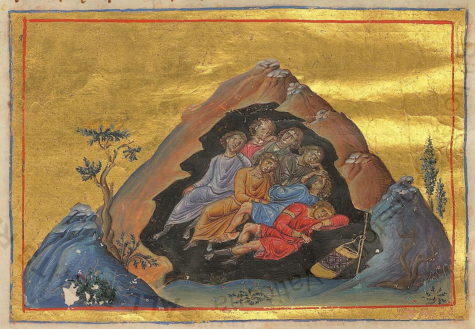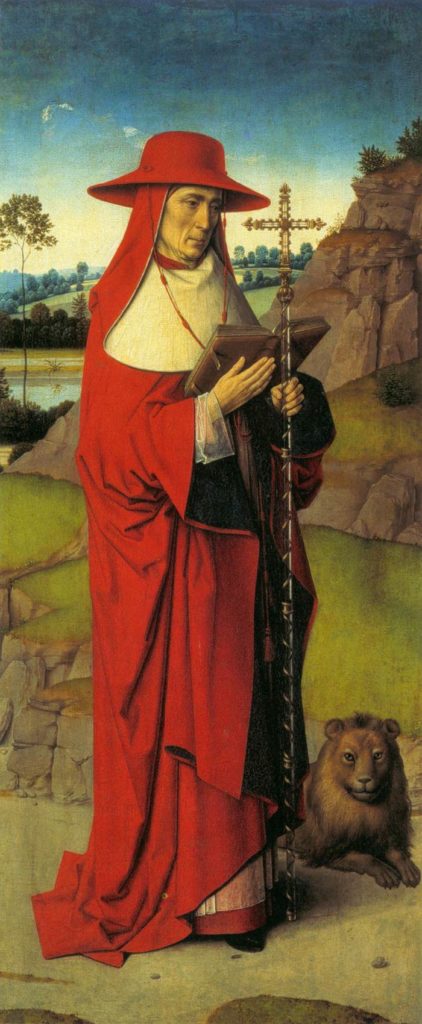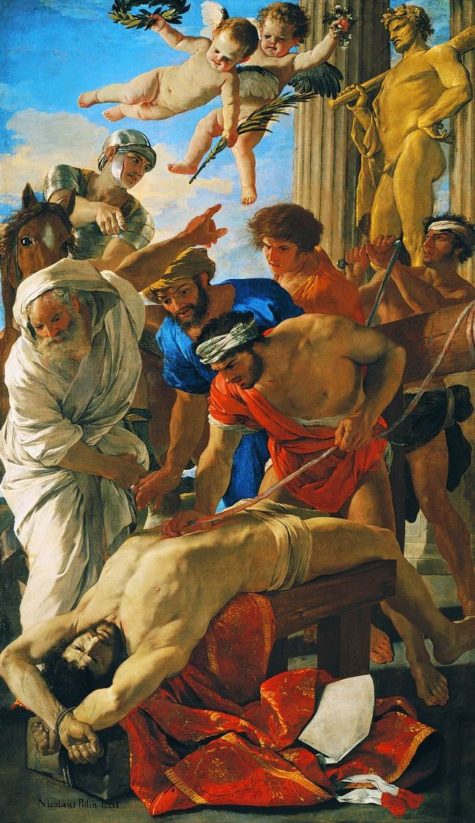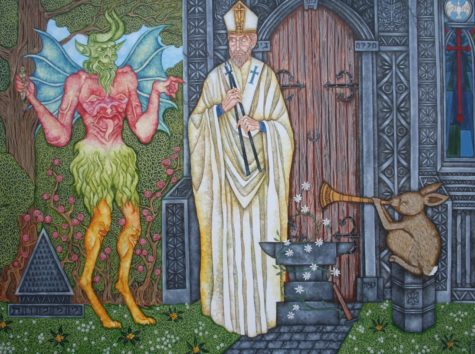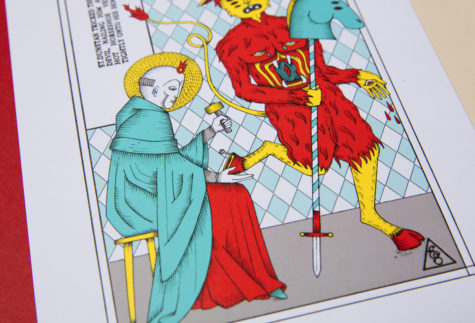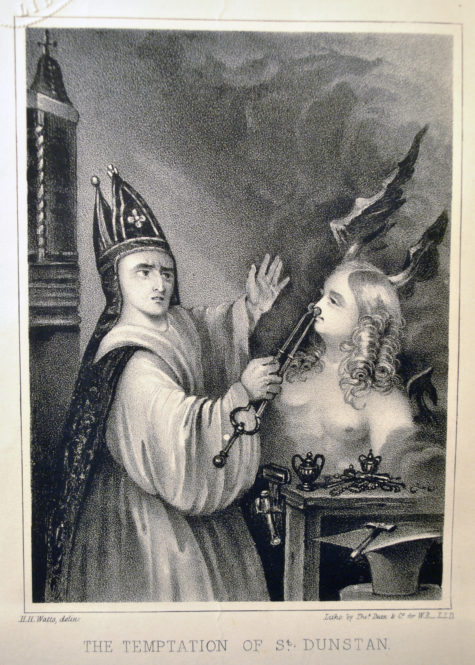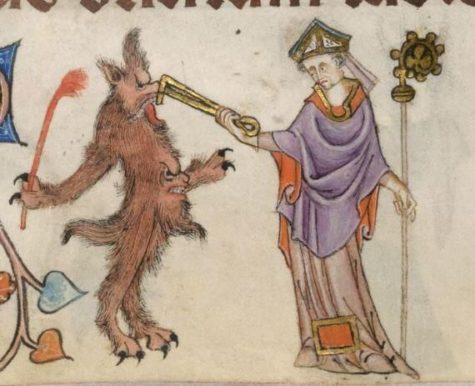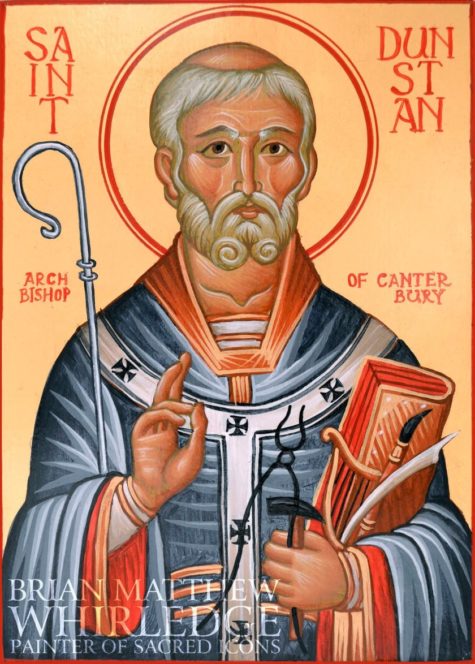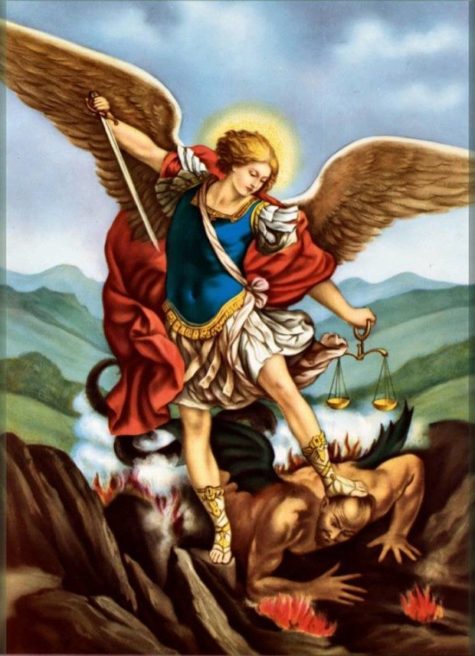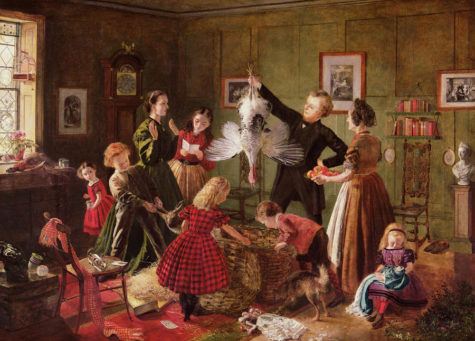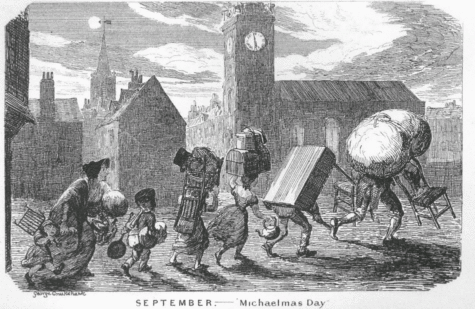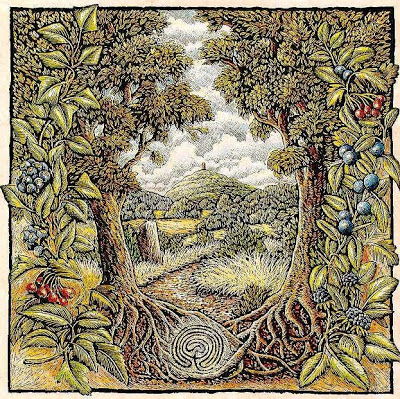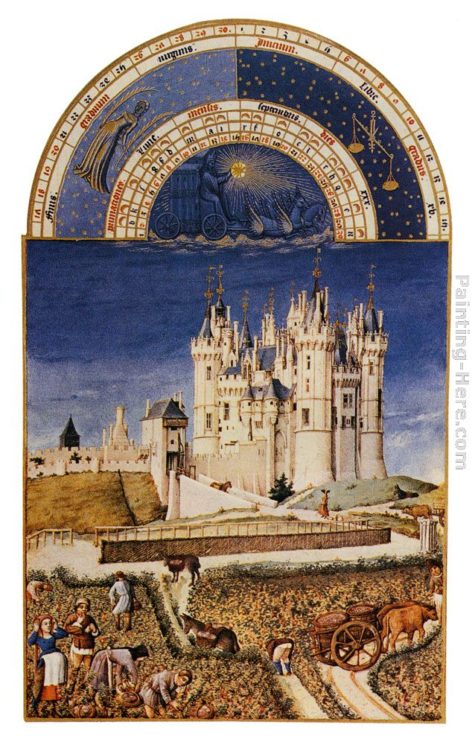Weather Watching
Seven Sleepers’ Day (Siebenschläfertag) on June 27 is a feast day commemorating the legend of the Seven Sleepers as well as one of the best-known bits of traditional weather lore (expressed as a proverb) remaining in German-speaking Europe.
The atmospheric conditions on that day are supposed to determine or predict the average summer weather of the next seven weeks. and it is believed that whatever the weather is on this day, it will remain so for seven weeks.
Apparently this forecast is about as accurate as Groundhog Day forecasts in the U.S. The story of the Seven Sleepers has many versions and is widespread throughout the Christian and Muslim worlds. It has been told and retold repeatedly from ancient times to the present day.
The Story of the Seven Sleepers
The earliest Syriac version of the tale states that during the persecutions of the Roman emperor Decius, around 250, seven young men were accused of being Christians. They were given some time to recant their faith, but chose instead to give their worldly goods to the poor and retire to a mountain cave to pray, where they fell asleep.
The emperor, seeing that their attitude towards their faith had not changed, ordered the mouth of the cave to be sealed. Decius died in 251, and many years passed during which Christianity went from being persecuted to being the state religion of the Roman Empire. At some later time—usually given as during the reign of Theodosius II (408–450)—the landowner decided to open up the sealed mouth of the cave, thinking to use it as a cattle pen. He opened it and found the sleepers inside.
They awoke, imagining that they had slept for a single day, and sent one of their number to Ephesus to buy food, with instructions to be careful in case the Romans were to recognize him and seize him. Upon arriving in the city, this youth was astounded to find buildings with crosses attached. The townspeople for their part were amazed to find a man trying to spend old coins from the reign of Decius. The bishop was summoned to interview the sleepers; they told him their miracle story, and died praising God.
As the earliest versions of the legend spread from Ephesus, an early Christian catacomb came to be associated with it, attracting scores of pilgrims. On the slopes of Mount Pion near Ephesus, the cave of the Seven Sleepers with ruins of the church built over it was excavated in 1927–28. The excavation brought to light several hundred graves which were dated to the 5th and 6th centuries. Inscriptions dedicated to the Seven Sleepers were found on the walls of the church and in the graves. This cave is now a local tourist attraction.
The story of the Seven Sleepers is probably best known in the Muslim world. It is told in the Qur’an (Surah 18, verse 9-26). The Qur’anic rendering of this story doesn’t state exactly the number of sleepers; the exact number is believed to be known to God alone. It also gives the number of years that they slept as 300 solar years (equivalent to 309 lunar years).
Unlike the Christian story, the Islamic version includes mention of a dog who accompanied the youths into the cave, and was also asleep. But when people passed by the cave it looked as if the dog was just keeping watch at the entrance, making them afraid of seeing what is in the cave once they saw the dog. In Islam, these youths are referred to as “The People of the Cave.”
There are numerous retellings of the tale in early modern and modern literature. John Donne’s (1572-1631) poem “The good-morrow” contains the lines:
were we not wean’d till then?
But suck’d on country pleasures, childishly?
Or snorted we in the Seven Sleepers’ den?”
A Recipe For Today
Given that the sleepers were hungry when they awoke and sent one of their number to buy food, I thought a local Turkish recipe found at roadside food stalls would be suitable for the day. Gözleme are flaky pastry packets stuffed with a mix of feta cheese and spinach plus herbs and spices. Variants can be found throughout Turkey and Greece. They can also be stuffed with ground lamb flavored with garlic, paprika, and cumin. Once in a while you will come across them with both fillings in one.
Ingredients:
Dough
- 2 cups (250 g) plain flour, unbleached
- 2 cups (250 g) wholemeal flour
- pinch of salt
- vegetable oil
Filling
- 2 cups (450 g) grated feta cheese or
- 2 cups (200 g) finely chopped spinach leaves
- ½ cup (50 g) chopped fresh mint leaves
- ½ cup (50 g)chopped flat leaf parsley
- ½ cup (80 g) chopped green onion
- ½ cup (80 g) diced white onion
- 1 tsp (5 g) white pepper
- 1 tsp (5 g) allspice
- 1 tsp (5 g) dried oregano
- 1 tsp (5 g) dried sage
Instructions:
Sift the flours and salt and mix with 1 ½ cups (210 ml) of water in an electric mixer with a dough hook or knead by hand for at least ten minutes.
Keep adding more water a little at a time until you get a very pliable, elastic dough that is easy to knead, but not so watery that it is too sticky to handle. Dust frequently with the extra flour.
Allow the dough to stand, covered, overnight (at least 10 hours). When ready to cook, divide the dough into six round portions. Dust with flour. Roll one of the rounds flat with a rolling pin on a flour-dusted surface, into a rectangle shape, as thinly as possible.
Brush on a little oil, then fold over into a square. Fold over twice more into a square. Repeat the dusting, rolling out to a large rectangle, folding, oiling, dusting process three more times. Repeat the entire process for each of the six rounds
Take one of the folded dough squares and roll it out very thinly for the final time, into a large square. Sprinkle on the filling sparingly – – as you would for a pizza topping but on half of the square only.
Start with a layer of cheese. Mix the spinach, mint, green onion and parsley together in a bowl, and add some of this as the next layer. Mix together the white onion, spices, and dried herbs, and add some as a final topping.
Fold over the uncovered half of the square to cover the filling. Press down lightly all over.
Cook on a pre-heated oiled heavy skillet (cast iron if possible). Make sure the skillet is not too hot. It takes about 10 minutes to cook everything through. Turn them often until the outside is golden and crisp. Cut into smaller squares and serve with lemon wedges. Yield 6.
Some Weather Science
The Seven Sleepers singularity is contested as quite inaccurate in practice. Objections have been raised that the weather lore associated with the day might have arisen before the 1582 Gregorian calendar reform, and as at this time the difference to the Julian calendar amounted to ten days, July 7 would be the actual Seven Sleepers Day. Based on this date the prediction has a slightly increased probability of about 55–70%, if confined to the southern parts of Germany, where the rule seems to have originated. In contrast, the weather lore is not applicable to Northern Germany and its rather oceanic climate.
Depending on the meandering flow of the polar jet stream in the Northern Hemisphere (Rossby waves) and the emergence of veering low-pressure and high-pressure (anticyclone) systems, the atmospheric conditions tend to stabilize in early July: either a high-pressure ridge takes hold over Scandinavia, which may coalesce with the subtropical Azores High to form a stable and warm macro weather situation; or a high North Atlantic oscillation between the Icelandic Low and the Azores High implies a long-standing influx of wet air masses into Central Europe.
Sources:
The 2nd of June is St Erasmus of Formia’s day – better known as St Elmo. He is said to have kept preaching during a thunderstorm and even when lightning struck near him. Sailors therefore look on the electrical discharges that hit masts or other protuberances as a sign that the saint is watching over them, and call this St Elmo’s Fire.
St. Elmo’s fire is a bright blue or violet glow, appearing like fire in some circumstances, from tall, sharply pointed structures such as lightning rods, masts, spires and chimneys, and on aircraft wings or nose cones. St. Elmo’s fire can also appear on leaves and grass, and even at the tips of cattle horns. Often accompanying the glow is a distinct hissing or buzzing sound. It is sometimes confused with ball lightning.
Invoking Saint Erasmus
In addition to being the patron saint of sailors, Saint Erasmus is also the patron saint of a host of other groups, including explosives workers, ordnance workers, and women in labor. He is also invoked against colic, birth pains, intestinal disorders, stomach diseases, and storms. He is one of the Fourteen Holy Helpers, a group of saints regarded as special protectors against various illnesses.
Invocation of St. Erasmus
Holy martyr Erasmus, who didst willingly and bravely bear the trials and sufferings of life, and by thy charity didst console many fellow-sufferers; I implore thee to remember me in my needs and to intercede for me with God. Staunch confessor of the Faith, victorious vanquisher of all tortures, pray Jesus for me and ask Him to grant me the grace to live and die in the Faith through which thou didst obtain the crown of glory. Amen.
Account of His Life and Martyrdom
Erasmus was Bishop of Formia, Italy. During the persecution against Christians under the emperors Diocletian (284-305) and Maximian Hercules (284-305), he left his diocese and went to Mount Libanus, where he hid for seven years. However, an angel is said to have appeared to him, and counseled him to return to his city.
On the way, he encountered some soldiers who questioned him. Erasmus admitted that he was a Christian and they brought him to trial at Antioch before the emperor Diocletian. After suffering terrible tortures, he was bound with chains and thrown into prison, but an angel appeared and helped him escape.
He passed through Lycia, where he raised up the son of an illustrious citizen. This resulted in a number of baptisms, which drew the attention of the Western Roman Emperor Maximian who, according to Voragine, was “much worse than was Diocletian.” Maximian ordered his arrest and Erasmus continued to confess his faith. They forced him to go to a temple of the idol, but along the saint’s route all the idols fell and were destroyed, and from the temple there came fire which fell upon many of the pagans.
That made the emperor so angry he had Erasmus enclosed in a barrel full of protruding spikes, and the barrel was rolled down a hill. But an angel healed him. Further tortures ensued.
When he was recaptured, he was brought before the emperor and beaten and whipped, then coated with pitch and set alight (as Christians had been in Nero’s games), and still he survived. Thrown into prison with the intention of letting him die of starvation, St Erasmus managed to escape.
He was recaptured and tortured some more in the Roman province of Illyricum, after boldly preaching and converting numerous pagans to Christianity. Finally, according to this version of his death, his stomach was slit open and his intestines wound around a windlass. This version may have developed from interpreting an icon that showed him with a windlass, signifying his patronage of sailors.
Sources:
Traditional weather lore has it that St. Dunstan was a great brewer who sold himself to the devil on the condition that the devil would blight the apple trees to stop the production of cider, Dunstan’s rival drink. This is said to be the cause of the wintry blast that usually comes about this time. (May 19)
Foggier yet, and colder! Piercing, searching, biting cold. If the good Saint Dunstan had but nipped the Evil Spirit’s nose with a touch of such weather as that, instead of using his familiar weapons, then, indeed, he would have roared to lusty purpose.
~A Christmas Carol
This piece of folklore seeks to explain the late May frosts, known as ‘Franklin Days’ in the West Country, which often hit between 17-19 or 19-21 May. The tale was apparently particularly popular in Devon in the 19th and 20th centuries and goes thus:
Dunstan had bought some barley and made some beer, which he then hoped to sell for a good price. Seeing this the Devil appeared before him and offered to blight the local apple trees with frost (the tale is presumably set in Somerset, perhaps when Dunstan is Abbot of Glastonbury). This would ensure there was no cider and so drive demand for beer. Dunstan accepted the offer but stipulated that the frost should strike from the 17-19 May.
Stories About St. Dustan and the Devil:
According to legend, St. Dunstan had a number of encounters with the devil. The most famous story, which entered popular folklore, tells how he pulled the devil by the nose with his blacksmith’s tongs.
The story goes that while he was living as a hermit in a cell at Glastonbury, he occupied himself with various crafts, including metalwork. Against the old church of St Mary he built a small cell five feet long and two and a half feet deep. It was there that Dunstan studied, worked at his handicrafts, and played on his harp. It is at this time, according to a late 11th-century legend, that the Devil is said to have tempted Dunstan.
One day, as evening was coming on, an old man appeared at his window and asked him to make a chalice for him. Setting aside what he was working on, Dunstan agreed to the request and set to work. But as he was working his visitor began to change shape: one moment he was an old man, then a young boy, then a seductive woman.
Dunstan realized that his guest was the devil; but, pretending not to notice, he went on with his task. He took up the tongs from among his tools and laid them in the fire, waiting until they were red-hot. Then, pulling them out of the fire, he turned round and seized the devil by the nose with the tongs. The devil struggled and screamed, but Dunstan held on until at last he felt he had triumphed. Then he threw the devil out of his cell and it fled, running down the street and crying “Woe is me! What has that bald devil done to me? Look at me, a poor wretch, look how he has tortured me!”
St Dunstan stood in his ivied Tower,
Alembic, crucible, all were there;
When in came Nick to play him a trick,
In guise of a damsel passing fair.
Every one knows
How the story goes:
He took up the tongs and caught hold of his nose.
~Lay of St Dunstan, 1840
Many people heard and saw this, and the following day they came to Dunstan and asked him what had happened. He said to them, “These are the tricks of devils, who try to trap us with their snares whenever they can. But if we remain firm in the service of Christ, we can easily defeat them with his help, and they will flee from us in confusion.” And from that time he dwelt safely in his little cell.
The story was of course retold in other forms, as here in playful fashion in the South English Legendary:
þe deuel he hente bi þe nose & wel faste drou;
He twengde & ssok hure bi þe nose þat þe fur out blaste.
þe deuel wrickede here & þere & he huld euere faste,
He 3al & hupte & drou a3en & made grislich bere.
He nolde for al is bi3ete þat he hadde icome þere!
Wiþ is tonge he strok is nose & twengde him euere sore,
Forte it was wiþinne ni3te þat he ne mi3te iseo namore.
þe ssrewe was glad & bliþe inou þo he was out of is honde
And flei & gradde bi þe lift þat me hurde into al þe londe:
“Out, wat haþ þis calwe ido? wat haþ þis calwe ido?”
In þe contreie me hurde wide hou þe ssrewe gradde so.
As god þe ssrewe hadde ibeo habbe ysnut atom is nose,
He ne hi3ede namore þuderward to tilie him of þe pose.
He seized the devil by the nose and pulled very hard; he tweaked and shook him by the nose so that fire burst out. The devil wriggled here and there, and he still held fast. He yelled and hopped and pulled away and made a horrible commotion. He wished for all the world that he’d never come there! With his tongs Dunstan yanked at his nose and nipped him very sore, until night came on and he could no longer see. The villain was glad and happy indeed that he was out of his hands, and fled and cried out so it was heard all over the land: “Alas, what’s this bald one done? What’s this bald one done?” It was heard far around how the wicked one cried out. The villain had got such a good tweaking of his nose, he never hurried back there again to heal his cold!
On another occasion, when Dunstan was praying alone, the devil appeared to him in the likeness of a wolf with a gaping mouth, snarling and baring his teeth. Dunstan would not be distracted from concentration on his prayers, so the devil suddenly changed himself into a little fox, trying to get Dunstan’s attention by jumping about, contorting himself and trying to get Dunstan to laugh at him.
But, smiling a little, Dunstan only said, “You are revealing how you usually behave: by your tricks you flatter the unwary so that you can devour them. Now get out of here, wretch, since Christ, who crushed the lion and the dragon with his heel, will overcome you by his grace through me, whether you’re a wolf or a fox.”
Another legend regarding the Devil and St. Dunstan also occurred in Mayfield when the convent there had just been built. The Devil appeared to St. Dunstan and said that he was going to knock down all the houses in the village. St. Dunstan bargained with the Devil and got him to agree to leave standing any house with a horseshoe on the outside. At that time, the custom of nailing horseshoes to doors for luck wasn’t well known so the Devil agreed but St. Dunstan managed to nail a horseshoe to all the houses in the village before the Devil could get to them so the village was saved.
The Devil managed to get some measure of revenge against St. Dunstan by repeatedly setting Mayfield church, then built of wood, off its normal East-West axis, leaving St. Dunstan to repeatedly correct it. According to the lore, this was accoplished by pushing the church back into the proper east-west alignment with his shoulder!
Another church is involved with yet another St. Dunstan story. This time it is the steeple of the church in the village of Brookland, just over the border into Kent. The Devil took the steeple and was chased by St. Dunstan who caused the Devil to drop the steeple near Hastings by application of the tongs mentioned in the Mayfield story.
According to one version of the story, the injured devil flew off from Mayfield to cool his nose in the springs of Tunbridge Wells, and that’s how its famous waters got their reddish tint (don’t let anyone tell you it’s because of the iron in the water). Alternatively, he flew away with the tongs still attached to his nose, and they dropped off in the place near Brighton which is now called Tongdean (for, I hope, obvious reasons).
About Saint Dustan:
- Feastday: May 19
- Patron of armorers, goldsmiths, locksmiths, and jewelers
Born of a noble family at Baltonsborough, near Glastonbury, England, Dunstan was educated there by Irish monks and while still a youth, was sent to the court of King Athelstan. He became a Benedictine monk about 934 and was ordained by his uncle, St. Alphege, Bishop of Winchester, about 939.
After a time as a hermit at Glastonbury, Dunstan was recalled to the royal court by King Edmund, who appointed him abbot of Glastonbury Abbey in 943. He developed the Abbey into a great center of learning while revitalizing other monasteries in the area. He became advisor to King Edred on his accession to the throne when Edmund was murdered, and began a far-reaching reform of all the monasteries in Edred’s realm.
Dunstan also became deeply involved in secular politics and incurred the enmity of the West Saxon nobles for denouncing their immorality and for urging peace with the Danes. When Edwy succeeded his uncle Edred as king in 955, he became Dunstan’s bitter enemy for the Abbot’s strong censure of his scandalous lifestyle. Edwy confiscated his property and banished him from his kingdom.
Dunstan went to Ghent in Flanders but soon returned when a rebellion replaced Edwy with his brother Edgar, who appointed Dunstan Bishop of Worcester and London in 957. When Edwy died in 959, the civil strife ended and the country was reunited under Edgar, who appointed Dunstan Archbishop of Canterbury. The king and archbishop then planned a thorough reform of Church and state.
Dunstan was appointed legate by Pope John XII, and with St. Ethelwold and St. Oswald, restored ecclesiastical discipline, rebuilt many of the monasteries destroyed by the Danish invaders, replaced inept secular priests with monks, and enforced the widespread reforms they put into effect. Dunstan served as Edgar’s chief advisor for sixteen years and did not hesitate to reprimand him when he thought it deserved.
When Edgar died, Dunstan helped elect Edward the martyr king and then his half brother Ethelred, when Edward died soon after his election. Under Ethelred, Dunstan’s influence began to wane and he retired from politics to Canterbury to teach at the Cathedral school and died there. Dunstan has been called the reviver of monasticism in England. He was a noted musician, played the harp, composed several hymns, notably Kyrie Rex splendens, was a skilled metal worker, and illuminated manuscripts.
Sources:
National Look Up At The Sky Day is celebrated annually on April 14 (some calendars have it listed as April 12). On this day we all hope for good weather and look to the skies to reflect on the beauty above us.
There are many things that you can see as you sit back, relax and look up. The sky’s beautiful blue color, the clouds and their many shapes, the sun (maybe peeking through the clouds), and many different birds flying around. If it is nighttime, you may find the sky filled with stars and a beautiful moon.
It’s a busy time of the year. Spring is arriving, people are upping their workout regimes in order to get ready for summer, the newness of the new year has worn off and we are all buckling in, and in the US it’s tax season. This is a perfect day to stop and look up at the sky. Take a moment and enjoy your surroundings and just breathe.
The creators of this holiday remain anonymous, but their goal is very clear: to encourage people to take a little time to slow down and appreciate the little things in life. People who spent a lot of their time looking at the sky include Nicholas Copernicus, who proved the earth revolved around the Sun (and not the other way around as previously thought) Albert Einstein, the creator of the Theory of Relativity, and Leonardo da Vinci, who envisioned the first flying machines, so rest assured you will be in the best of company!
How to Celebrate Look Up at the Sky Day
As the name of this little holiday itself suggests, take some time to look up at the sky! We sometimes take natural beauty for granted, and only pay attention to the sky if, say, it happens to be raining and we want to complain. So take a blanket out to the park and just lay down on it and gaze upwards for a while—you’re likely to be amazed at how it changes depending on wind and other factors.
Watching birds go abut their lives as if nothing of importance was going on down below at all will likely be relaxing, and watching planes soaring high above you may even motivate you to take a trip to some faraway land. Look Up at the Sky Day was created to motivate us to see the world from a different perspective than we usually do and appreciate the beauty of nature, so make sure you get out and celebrate and make your life just a little bit more meaningful!
Sources:
Groundhog Day, a U.S. and Canadian tradition, comes every year on February 2. It has its roots in astronomy, in the sense that it’s a seasonal festival, tied to the movement of Earth around the sun. It’s the year’s 1st cross-quarter day. It is also a great excuse to go outside and enjoy some revelry during the winter months.
Groundhog Day is a secular version of Candlemas. Some countries believed that a burrowing animal, usually a hedgehog, would come out on this day to judge the quality of the weather. This tradition came with settlers to the New World. There were no hedgehogs to be found, but there were lots and lots of groundhogs. Thus Groundhogs’ Day was born.
Who is Punxsutawney Phil?
In the United States, Groundhog Day is a long standing tradition. However, the idea of looking at a burrowing animals’ reactions to the weather is an even older custom.
According to tradition if the animal sees its shadow, it is a sign there will be six more weeks of bad weather or a “second winter” and scurries back into his hole. However, if it doesn’t see his shadow, he comes out to stay. So, on a cloudy day it would not see a shadow and would thus know spring is coming.
If the groundhog sees his shadow
we will have six more weeks of winter.
Settlers in Pennsylvania were of German decent. The groundhog is abundant in these parts and the settlers decreed this creature would be the weather predictor of record. The most famous of all the groundhogs lives in Punxsutawney.
In the 1880s, a group of friends went out on Candlemas Day in search of a groundhog. This trip quickly became tradition and the local newspaper dubbed the group “The Punxsutawney Groundhog Club.” In 1887, the search turned into an official event and the groundhog became known as Punxsutawney Phil. Phil makes his yearly appearance to predict the weather, which is televised and announced on the radio.
Today good ol’ Punxsutawney Phil makes his home in a climate-controlled “burrow” that is next to the Punxsutawney Library. Phil even became a movie star in 1993 when the movie Groundhog Day with Bill Murray opened.
Punxsutawney Phil is not the only weather predicting animal of note however there is also:
- Pothole Pete in New York City
- Birmingham Bill in Birmingham, Alabama
- Buckeye Chuck in Marion, Ohio
- General Beauregard Lee in Georgia
- Unadilla Bill in Nebraska
- French Creek Freddy in West Virginia
- Shubenacadie Sam in Canada, and
- Wiarton Willie, Canada’s albino groundhog
- There’s even Claude the Cajun Crawfish in Louisiana, if he “waves his claws toward the sun, he is signaling the cold spell will come to an end.”
Activities for Groundhog Day
- Casting Shadow: Outline your feet in a sunny area in chalk. Mark the length and movement of your shadow every hour.
- Charting and predicting the weather: Note the type of weather on the calendar for two weeks, then make a bar graph and predict the weather for the coming week.
In southeastern Pennsylvania, Groundhog Lodges (Grundsow Lodges) celebrate the holiday with fersommlinge, social events in which food is served, speeches are made, and one or more g’spiel (plays or skits) are performed for entertainment. The Pennsylvania German dialect is the only language spoken at the event, and those who speak English pay a penalty, usually in the form of a nickel, dime, or quarter per word spoken, with the money put into a bowl in the center of the table.
Source: Web Holidays
There is one twist on that old groundhog day legend that goes like this: “When the bear sees his shadow at Candlemas; he will crawl back into his hole for another six weeks.”
In Croatia and Serbia, Orthodox Christians have a tradition that on February 2 (Candlemas) or February 15 (Sretenje, The Meeting of the Lord), the bear will awaken from hibernation, and if it sees (meets) its own shadow in this sleepy and confused state, it will get scared and go back to sleep for an additional 40 days, thus prolonging the winter. But, if a bear does not see his shadow, he will remain outside, which means that hibernation period is over and that spring will soon start.
Thus, if it is sunny on Sretenje, it is a sign that the winter is not over yet. If it is cloudy, it is a good sign that the winter is about to end. Romania and Hungary also watch for bear shadows on February 2.
In certain areas of England there was an expression that if a dark moon came on Christmas, a fine harvest year would follow. Other areas declared that a waxing or new moon on Christmas portended a good year, but a waning moon a hard year.
From: Moon Magick
September 29th is a medieval holiday which the Church Christianized under the label of “Michaelmas,” a feast in honor of the Archangel Michael. It is thought that the Roman Catholic Church at some point considered assigning the quarter dates to the four Archangels, since they had assigned the cross quarters to the four gospel-writers.
The feast day of St. Michael, the archangel and overcomer of the Devil, is a Christian celebration. Its main importance in people’s lives was that of a seasonal signpost in the year. In the British Isles, crops were harvested and the surplus sold by late September, so this became the time when farmers would pay their yearly rents to landowners.
Everyone ate goose at Michaelmas to bring prosperity, and many farmers included “a goose fit for the lord’s dinner” with their rent payments. Great market fairs occurred just before the feast day, and the large crowds these attracted made it convenient to hold elections at this time. Michaelmas is also a “Quarter Day.”
The ancient Celtic people divided the year into four major sections, or quarters, and then divided each of these in half to make an eight-part year that reflected the natural progression of the seasons. Foods traditional for Michaelmas include new wine; goose; cakes of oats, barley, and rye; and carrots. Some groups in the United States, such as the Pennsylvania Dutch, have kept Michaelmas, or “Harvest Home,” traditions alive.
During the Middle Ages, Michaelmas was celebrated as a Holy Day of Obligation, but this tradition was abolished in the 18th century. Lutheran Christians consider it a principal feast of Christ.
It was also one of the Welsh and Irish quarter days when accounts had to be settled. On manors, it was the day when a reeve was elected from the peasants. Traditional meal for the day includes goose (a “stubble-goose”, i.e. one prepared around harvest time) and a special cake called a St Michael’s bannock.
A Note About Dates:
There is evidence that Michaelmas was once celebrated later in the year, on the 10th or 11th of October, this is now referred to as ‘Old Michaelmas Day’. There may also have been a time when both dates for Michaelmas were acknowledged.
I like the legend of teenage girls collecting crab apples at the beginning of September, and arranging them in the initials of boys they fancied. If they could still discern the initials on Old Michaelmas Day, then then true love and romance would follow. The legend conjures two unrelated thoughts in my mind, firstly, would other girls mischievously re-arrange the apples to form the initials of a different boy. Secondly, what is the modern equivalent of this courtship ritual?
It’s interesting that certain customs transfer from one season to another. For example, two people snapping the the Michaelmas goose’s wishbone and thinking of a secret desire. Also, the concept of a Michaelmas Pie with ring, according to this legend, the lucky recipient will be engaged by Christmas and marry by Easter. Variations on these themes occur at Christmas and possibly at Thanksgiving.
Michaelmas Customs and Lore
According to an old legend, blackberries should not be picked after this date.
This is because, so folklore goes, Satan was banished from Heaven on this day, fell into a blackberry bush and cursed the brambles as he fell into them. In Yorkshire, it is said that the devil had spat on them. This old legend is well known in all parts of the United Kingdom, even as far north as the Orkney Islands. In Cornwall, a similar legend prevails, however, the saying goes that the devil urinated on them.
This is one Michaelmas custom that survives to this day, although sometimes it is said that you should not eat blackberries after the 29th of September. There is a very good reason for this custom, namely that by this time of year blackberries are tasteless and watery.
Other fruits, particularly nuts and rose-hips also have customs associated with Michaelmas. For example, ‘Hipping Day’ in Yorkshire, or Michaelmas pie in Ireland (Made of apples).
- Mop Fairs (Hiring Time):
Michaelmas was traditionally time when laborers and servants were hired. As the name suggests, maids would carry mops, but other trades carried the tools of their trades.
Thus the squires or the lord’s of the manor could tell what skills the prospective employees had, for example, a Shepherds his crook, and a gardener a rake.
- Fishing:
Michaelmas marks the end of the fishing season.
- Curfew:
The start of the curfew for winter night nights. The local church bell sounded each night from Michaelmas until lent. Curfew is derived from the French phrase ‘courve feu’, which means to cover, or to dowse a fire.
- Rent:
When tenants came to pay their quarter’s rent, they bring a fowl at Midsummer, a dish of fish in Lent, a capon at Christmas, and on Michaelmas Day, a goose.
- Trees:
This is traditionally a good time to plant trees as evidenced by this old saying, “A Tree planted at Michaelmas, will surely not go amiss.”
More Michaelmas Lore:
At Michaelmas time, or a little before,
Half an apple goes to the core;
At Christmas time, or a little after,
A crab in the hedge, and thanks to the rafter.
- If you eat goose on Michaelmas Day, you will not be short of money all year round.
- A Michaelmas rot comes ne’er in the pot.
- If St Michael brings many acorns, Christmas will cover the fields with snow.
- Michaelmas chickens and parsons’ daughters never come to good.
- Three things that never come to any good: Christmas pigs, Michaelmas fowls, and parsons’ daughters.
- So many days the moon is old on St Michael’s day, so many floods after.
- Harvest comes as long before Michaelmas as dog roses bloom before Midsummer.
- On Michaelmas Day the devil puts his foot on the blackberries.
- St Michael’s rain does not stay long in the sky.
- If it does not rain on St Michael’s and Gallus [Oct 16], a dry spring is indicated for the next year.
Collected from a variety of sources
September gets its name from the Latin word septum, meaning “seven,” because it was originally the seventh month in the old calendar system. The Anglo-Saxons called it Gerst monath (Barley month), because it was their time to harvest barley to be made into their favorite drink – barley brew. They also called it Haefest monath or Harvest month.
While the early portion of this month has many summery-feeling festivals, slowly we see a change in focus toward the fall and harvest celebrations. Children return to school, outdoor activities start to wane, and the Wheel of Time begins to paint the trees with color.
September’s energy augments magic for prosperity and abundance, balanced with sensibility and a little frugality. It is especially a time for rituals that thank the goddess for all her gifts throughout the year. Beyond this, start making amulets for health so that when the cooler winds come, you’ll be magically fortified.
According to the lore, September is a great month in which to marry:
- Marry in September’s shrine, your living will be rich and fine.
- Married in September’s golden glow, Smooth and serene your life will go.
- A September bride will be discreet, affable, And much liked.
September Correspondences
- Nature Spirits: Trooping faeries
- Herbs: Copal, Fennel, Rye, Wheat, Valerian, Skullcap
- Colors: Brown, Yellow-Green, Yellow
- Flowers: Narcissus, Lily, Aster
- Scents: Storax, Mastic, Gardenia, Bergamot
- Gem: Sapphire
- Stones: Peridot, Olivine, Chrysolite, Citrine
- Trees: Hazel, Larch, Bay
- Animals: Snake, Jackal
- Birds: Ibis, Sparrow
- Deities: Demeter, Ceres, Isis, Nephthys, Freyja, Ch’ang-O, Thoth
- Full Moon: Harvest Moon
- Autumn Equinox: Nature comes into balance
Power flow:
Rest after labor; Balance of Light and Dark. Organize. Clean and straighten up physical, mental, emotional, and spiritual clutter.
September Weather Lore
- Fair on September 1st, fair for the month.
- Heavy September rains bring drought.
- If on September 19th there is a storm from the south, a mild winter may be expected.
- If St. Michael’s (Sept 29) brings many acorns, Christmas will cover the fields with snow.
September Festivities
The Autumn Equinox was and is celebrated still by many cultures around the world. This month is the last of the reliable harvesting months in the Northern Hemisphere. Life is beginning to wind down in preparation for the dormant months that follow. The energy flows from the Autumn Equinox through Winter Solstice to the Spring Equinox are gentler, deeper, more hidden. The Dark Moon deities, who represent the Underworld, death, reincarnation, and deep spiritual mysteries, now hold sway.
The Egyptian Ceremony of Lighting the Fire was a general festival of lights for all the gods and goddesses. Lamps of all kinds were set in front of deity statues. They were also placed before the statues of ancestors.
The Egyptian deity Thoth was the Lord of Holy Words and inventor of the Four Laws of Magick. Portrayed as ibis-headed, Thoth was a Moon god. As Supreme Magus, or the Ultimate Magician, he had control over the powers and attributes of the Moon.
In the old Incan Empire, the Citua was held on the New Moon nearest the Autumn Equinox. Everyone performed a ritual cleansing, then smeared their faces with a paste of ground maize. There followed several days of feasting and dancing. This was a moon festival in honor of Mama Quilla, the Moon goddess.
Gauri, or the Fair One, is not a well known goddess of India. She is considered to be an aspect of the goddess Durga. Gauri is honored by eating sweets made from honey to bring sweetness to the soul.
The most famous holy celebration of this time of year was the annual Greek festival called the Greater Eleusinia. It honored Demeter, Kore-Persephone, and the holy child Iacchus. Unlike the Lesser Eleusinia held in the Spring, this celebration was open only to initiates who were under strict rule of silence about what occured.
The Greek goddess Themis was the Titaness daughter of Uranus and Gaea. She was the mother of Atlas and Prometheus and the mother by Zeus of the Horae and the Moerae (Furies). Since she was the deity of social order and collective consciousness, the Olympians held her in high respect. Holding a pair of scales, Themis protected the innocent and punished the guilty. She ruled Delphi after her mother Gaea, but relinquished it to Phoebe who gave it to Apollo.
The annual festival of Yue-ping was held in China from the New Moon to the Full Moon. People made round cakes and painted figures of women or a hare and trees on them. These were called Yue-ping, or “Moon cakes.” These cakes were presented to relatives and friends.
The Chinese said that the Moon Mother had twenty-eight “houses) (Hsiu) and rested each night in a different one. In each “house” she kept a warrior-hero consort who kept her company and did her bidding.
Sources: 365 Goddess and Moon Magic
The phrase “Dog Days” refers to the hottest days of summer. The Old Farmer’s Almanac lists the traditional timing of the Dog Days: the 40 days beginning July 3 and ending August 11, coinciding with the heliacal (at sunrise) rising of the Dog Star, Sirius.
The rising of Sirius does not actually affect the weather (some of our hottest and most humid days occur after August 11), but for the ancient Egyptians, Sirius appeared just before the season of the Nile’s flooding so they used the star as a “watchdog” for that event. Since its rising also coincided with a time of extreme heat, the connection with hot, sultry weather was made for all time.
More about the Dog Days can be found here: Dog Days of Summer
Source: Almanac.com
